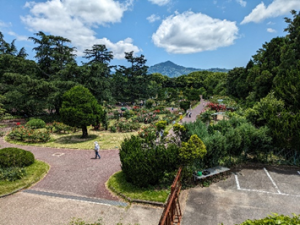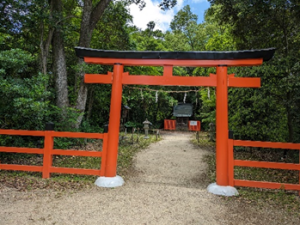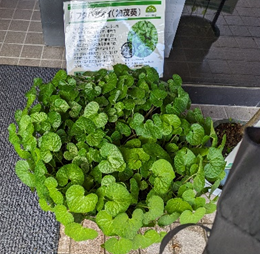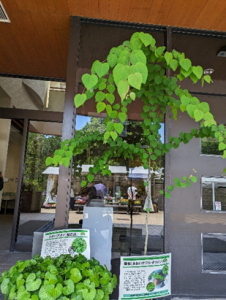Yasunari Kawabata’s birthday month: June <2>
Yoshie Doi
 A rose garden with Mt. Hiei as a backdrop. Photographed on June 5, 2024 |
 Nakagi Shrine in the botanical garden. Photograph taken on the same day. |
 Futaba Aoi |
 Katsura tree |
When I visited in June, I was guided by Mr. Hiroyuki Nikuto, deputy director of the Kyoto Prefectural Botanical Gardens, and was able to feel the charm of the botanical gardens. Thank you very much. I also heard from Ms. Mariko Shimizu, the proprietress of the restaurant Shogetsu , which faces Kitaoji-dori, about what it was like just after the war when GHQ was living there.
The Kyoto Prefectural Botanical Gardens, which appear in “The Old Capital,” were designated as a residential area for the families of the occupying forces by GHQ (General Headquarters of the Allied Powers) in 1946 after the end of the war. Therefore, many negotiations were held on the condition that the eastern and southern parts of the gardens be left intact, and construction began.
Construction work began in the fall of 1946 (Showa 21), and the number of trees in the park was reduced from 25,000 to 6,000, with 19,000 trees cut down. The rock gardens and medicinal herb gardens were turned into wide roads by bulldozers. Fortunately, the camphor tree-lined path remained as it is to this day.
The entire botanical garden was returned to Kyoto Prefecture on December 12, 1957 (Showa 32), but it was not actually returned to Kyoto Prefecture until one year later, on December 26, 1958, and reopening thereafter was a difficult process. It seems that the efforts to restore what had been a botanical garden for about 20 long years during and after the war were no mean feat.
As plans to rebuild the returned botanical gardens progressed, they were temporarily opened to the public free of charge in the spring of 1959, and many Kyoto residents came to see the gardens, which had lost their role for nearly 20 years during and after the war. As the tulips from Tango bloomed, 155,000 visitors flocked to the gardens over the 12 days from April 15th. In particular, on the final day of the opening, Sunday, 70,000 people came to enjoy the botanical gardens (The recent years’ data shows that the highest number of visitors was 20,000 in a single day).
”The Old Capital” also states, “When we entered the botanical garden, tulips were blooming around the fountain in front. ‘A view unlike anything else in Kyoto,’ Shige remarked. ‘ I’m sure someone from America must have built a house here.'” It also says that some people held matchmaking meetings in front of these tulip fields, showing how Kyoto people, who love new things, enjoyed the lovely tulips.
There is a shrine within the botanical garden. It is located exactly halfway between Kamigamo Shrine and Shimogamo Shrine within the botanical garden, and is a Keigai-Masha(sub-shrine outside the precincts) of Kamigamo Shrine.
When you think of Kamigamo Shrine and Shimogamo Shrine, the Aoi Festival comes to mind, and festivals are also closely related to flowers and trees. The Aoi Festival is held during the time when the Aoi Flower blooms. Everyone in the Aoi Festival procession wears a Aoi Flower that creeps along the ground and a katsura tree that stretches as if reaching for the sky. They wear both a Aoi Flower and a katsura tree so that the heavens and the earth are united.
This Nakaragi Shrine was originally called Nagaregi Shrine, but is now called Nakaragi Shrine. The original founding date is unknown, but it is said that the shrine was built using driftwood that washed up during a flood.
The most popular camphor trees in the area are now over 100 years old, thanks to having been spared from cutting. The precious plants were also dispersed and entrusted to botanical gardens in Osaka and Nagoya, and were returned to Kyoto when the botanical gardens were returned to Japan.
I’m sure that Yasunari Kawabata also visited this botanical garden many times and enjoyed the flowers and trees of all four seasons.
When the occupying forces took over the area, the residents around the botanical garden were told that they would be shot if they went inside, but even when they did, they would pick up the children and take them outside. Also, when members of the GHQ came to eat at the restaurant, they would bring meat and sugar as souvenirs and interact with them in a friendly manner.
I learned that even though people were of different races, cultures and languages, they still interacted with each other as human beings, and I was able to hear how they treated each other with kindness even during the turmoil after the war. (Continued)
The end of document
Translated by Masami Otani
